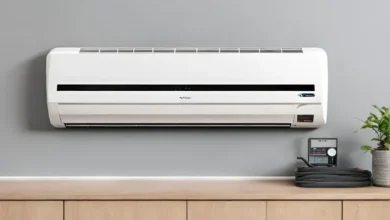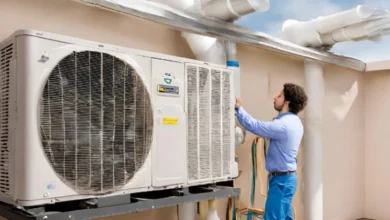Troubleshooting Guide for Common AC Issues

The relentless heat of India makes air conditioning not just a comfort but a necessity. When your AC malfunctions, it can be frustrating and uncomfortable. This detailed troubleshooting guide is designed to help you identify and resolve common air conditioner issues in India, providing a comprehensive approach to maintaining a cool and comfortable indoor environment.
Also read: Best AC in India 2024
Common AC Issues in India
1. Poor Cooling Performance
Potential Causes:
- Thermostat Issues: Incorrect thermostat settings can lead to poor cooling. Ensure the thermostat is set to the desired temperature.
- Clogged Filters: Dirty or clogged filters restrict airflow, reducing the cooling efficiency of the AC unit.
- Refrigerant Levels: Insufficient refrigerant levels can hamper the cooling process.
Troubleshooting Steps:
- Thermostat Check:
- Verify that the thermostat is set to the appropriate temperature. If uncertain, try lowering it a few degrees to see if there’s an improvement.
- Consider investing in a programmable thermostat for precise temperature control.
- Filter Inspection:
- Regularly inspect and clean or replace filters every 1-2 months to maintain optimal airflow.
- Consider using high-efficiency particulate air (HEPA) filters for improved air quality.
- Refrigerant Assessment:
- If cooling issues persist, consult a professional to check and recharge refrigerant levels.
- Address any refrigerant leaks promptly to maintain system efficiency.
2. Water Leakage
Potential Causes:
- Clogged Drain Pipe: Over time, the drain pipe may get clogged with debris, leading to water leakage.
- Malfunctioning Pump: A faulty condensate pump can result in water overflow.
- Evaporator Coil Issues: Ice buildup on the evaporator coil can cause water leakage when it melts.
Troubleshooting Steps:
- Clear the Drain Pipe:
- Remove any blockages or algae from the drain pipe using a wet/dry vacuum or a pipe cleaner.
- Consider installing a condensate drain line with an anti-algae tablet to prevent future clogs.
- Pump Inspection:
- Ensure the condensate pump is functioning correctly. If not, consider professional repairs or replacement.
- Regularly test the pump to avoid potential water damage.
- Evaporator Coil Defrosting:
- Turn off the AC to allow the ice on the evaporator coil to melt.
- Address any issues with the refrigeration cycle that may be causing excessive ice buildup.
3. Strange Noises
Potential Causes:
- Loose Parts: Vibrations or rattling sounds may occur if any components within the AC unit are loose.
- Debris in the Unit: Leaves, twigs, or other debris can find their way into the unit, causing strange noises.
- Damaged Fan Blades: Misaligned or damaged fan blades can produce buzzing or squealing sounds.
Troubleshooting Steps:
- Tighten Loose Parts:
- Inspect the unit for loose screws or components and tighten them.
- Consider using lock washers or thread-locking compounds for added stability.
- Unit Cleaning:
- Remove any debris from the unit, keeping it free of external obstructions.
- Trim nearby vegetation and create a clear space around the outdoor unit.
- Fan Blade Inspection:
- Carefully examine the fan blades for damage or misalignment. If issues persist, seek professional assistance.
- Lubricate fan bearings to reduce friction and noise.
4. Foul Odors
Potential Causes:
- Dirty Filters: Accumulated dirt and debris on filters can produce unpleasant odors.
- Mold Growth: Mold or bacteria growth on the evaporator coil or in the drain pan can lead to foul smells.
- Stagnant Water: If water remains stagnant in the drip pan, it can develop a musty odor.
Troubleshooting Steps:
- Filter Maintenance:
- Clean or replace filters regularly to prevent the buildup of odor-causing particles.
- Use filters with activated carbon or other odor-absorbing materials.
- Mold Inspection:
- Examine the evaporator coil and drain pan for mold. Clean the affected areas using a mild solution of water and vinegar.
- Install UV light systems to inhibit mold and bacteria growth within the AC unit.
- Drip Pan Drainage:
- Ensure the drip pan is draining properly to prevent stagnant water. Clean the pan regularly to prevent odors.
- Consider installing a condensate pan treatment to control microbial growth.
5. AC Not Turning On
Potential Causes:
- Thermostat Settings: Incorrect thermostat settings or a malfunctioning thermostat can prevent the AC from turning on.
- Circuit Breaker Issues: A tripped circuit breaker can interrupt power supply to the AC unit.
- Capacitor Problems: A faulty capacitor may hinder the AC’s ability to start.
Troubleshooting Steps:
- Thermostat Check:
- Confirm that the thermostat is set to the cooling mode and the desired temperature.
- Replace batteries in programmable thermostats to ensure proper function.
- Circuit Breaker Inspection:
- Check the circuit breaker panel for any tripped breakers related to the AC. Reset if necessary.
- Consider dedicated circuits for the AC unit to prevent overloads.
- Capacitor Evaluation:
- If the AC still doesn’t start, consult a professional to inspect and potentially replace a malfunctioning capacitor.
- Regularly inspect and test capacitors during routine maintenance checks.
Conclusion
In the dynamic climate of India, a functional air conditioner is crucial for maintaining indoor comfort. By understanding common AC issues and following the detailed troubleshooting steps outlined in this guide, you can address problems promptly and effectively. Regular preventive maintenance enhances the longevity and performance of your AC unit, ensuring it remains a reliable companion during the sweltering Indian summers. Stay cool and comfortable!






